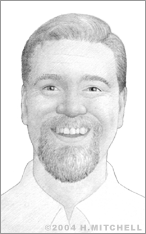Fred Thomas
Engineer and inventor Fred C. Thomas was born on October 25, 1959 in Washington D.C. With his diplomat parents he traveled and lived all over the world, including time spent in Pakistan, South Vietnam, India, Taiwan, Germany and the Philippines, as well as the United States. His father had been an electrical engineer earlier in his career, and it was he who inspired his son’s interest in technology, especially solar energy. When the younger Thomas began to see media coverage of innovations that were very similar to ideas he had years earlier, he realized he might have a special talent for developing new technological concepts. He entered Bucknell University in Lewisburg, Pennsylvania where he completed his BS in Mechanical Engineering in 1983.
That year, Thomas began working for Texas Instruments Defense Systems in Dallas, first as an electro-optics systems engineer and later as manager of the Laser Ranging Systems Test Group. There he was responsible for a number of innovations related to testing and analysis. He parlayed this experience into his own business, Prototype Devices, which he operated until 1991. Meanwhile, he completed his MS in Mechanical Engineering at Bucknell in 1990.
In 1991, Thomas joined the Iomega Corporation, working his way up from mechanical product design engineer, to Chief Technologist in the Advanced R&D division. At Iomega, Thomas has become one of the most prolific innovators in the company’s 25-year history, with more company inventions to his credit than any other employee. He has over 32 patents on technologies developed for the organization.
One of Thomas’ first projects for the company was the LightSaber laser servowriter, which was honored with the 1994 Electro-Optic Application of the Year Award from Laser Focus World magazine. Thomas was responsible for the electro-optic design on the device, which made possible very high density storage by using an acousto-optically controlled argon-ion laser to etch more than 1.5 million servo marks on a 3.5-inch Floptical disk.
As Iomega Corporation's all-time leading inventor, over the last decade Thomas has been responsible for such advances as TrueLuminous technology - which uses glow-in-the-dark materials (phosphors) to identify and authenticate data storage cartridges and other articles -- as well as critical components of Iomega products such as the Floptical Drive, Zip Drive, Jaz Drive, Peerless Drive and REV Drive. Thomas was also one of the original inventors of the company’s micro-magnetic data storage technology, the Clik! drive, that was later renamed the Pocket Zip. For one of these developments, Thomas received one of Iomega’s prestigious “Exceptional Invention Awards.”
The types of removable data storage products Iomega builds involve the “interplay of several technologies and engineering sciences,” Thomas said, including electronics, mechanisms, dynamics of spinning bodies, plastics, magnetics, precision actuators, sensors and motors, among others. “Inventing is all about bringing as big and varied a set of technologies and new materials to bear on a challenging problem as possible,” said Thomas.
One of his most exceptional inventions is AO-DVD technology. The "AO" in AO-DVD stands for "Articulated Optical,” a term that describes the tilted orientation of small reflective facets in the surface of data storage elements found on a DVD-like, plastic data storage disc. With typical DVD technology, a small, focused spot of laser light is reflected from the DVD disc's surface. In that area, roughly equivalent to the focused laser spot's size, one bit of data is stored. That area either reflects a lot of light or just a little light. Hence, there are two-levels (1 or 0) stored in that small location on the DVD disc.
With AO-DVD, however, a new enabling technology called “e-beam mastered gray-scale lithography” gives this same small area of the disc some predefined three-dimensional reflective topography. That way, not only can one control whether the spot reflects back or not (like DVD), but one can split the reflected laser beam back into multiple paths with each path having a unique positional and phase orientation, or state, relative to all the other reflective paths. By using an appropriate electronic detection scheme, one can encode thousands, if not millions, of different states in the same area used by a DVD to record just two states. Using this mechanism, future optical distribution discs such as the AO-DVD could potentially hold 50-100 times more information than today's DVDs at similarly low costs.
Iomega has reduced investment into new optical data storage technologies, thus, according to Thomas, AO-DVD is still in want of corporate support to bring it to market. It is an idea that is a bit ahead of its time.


